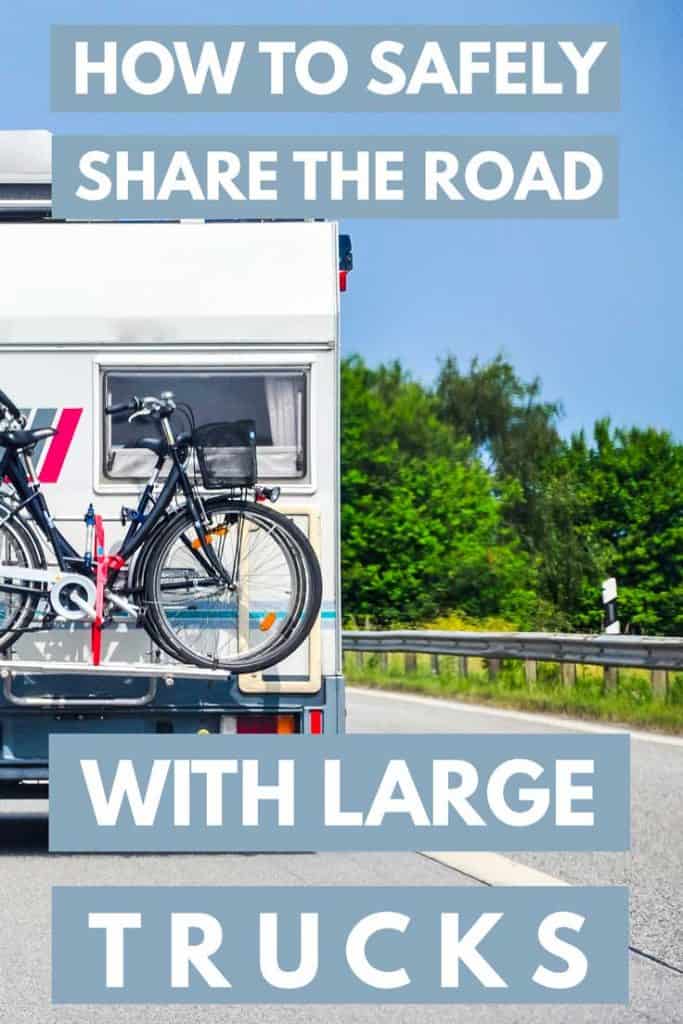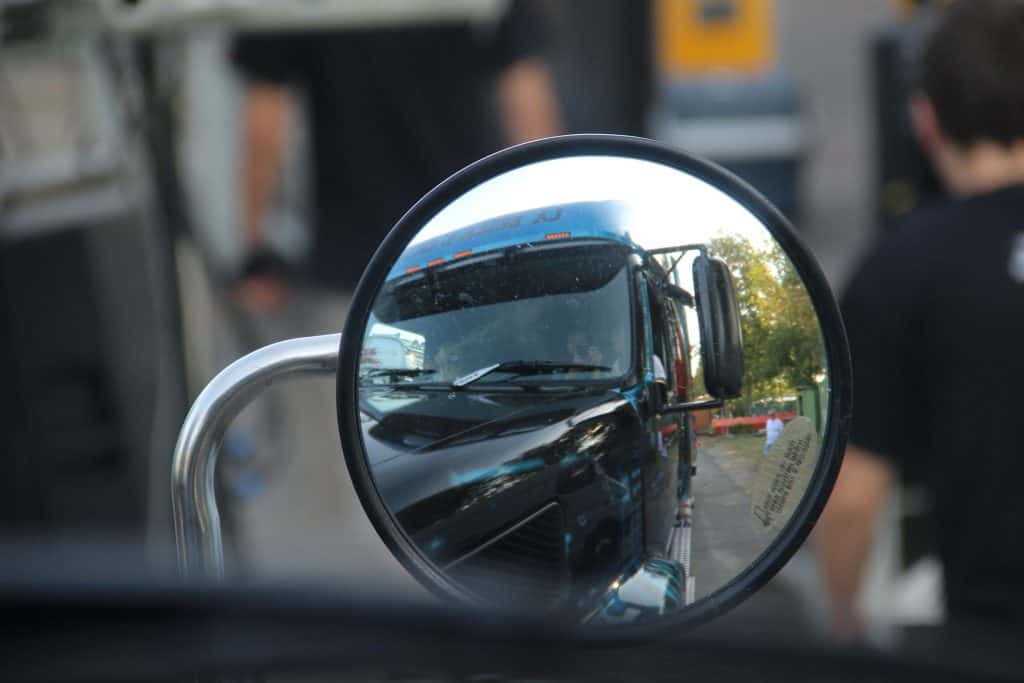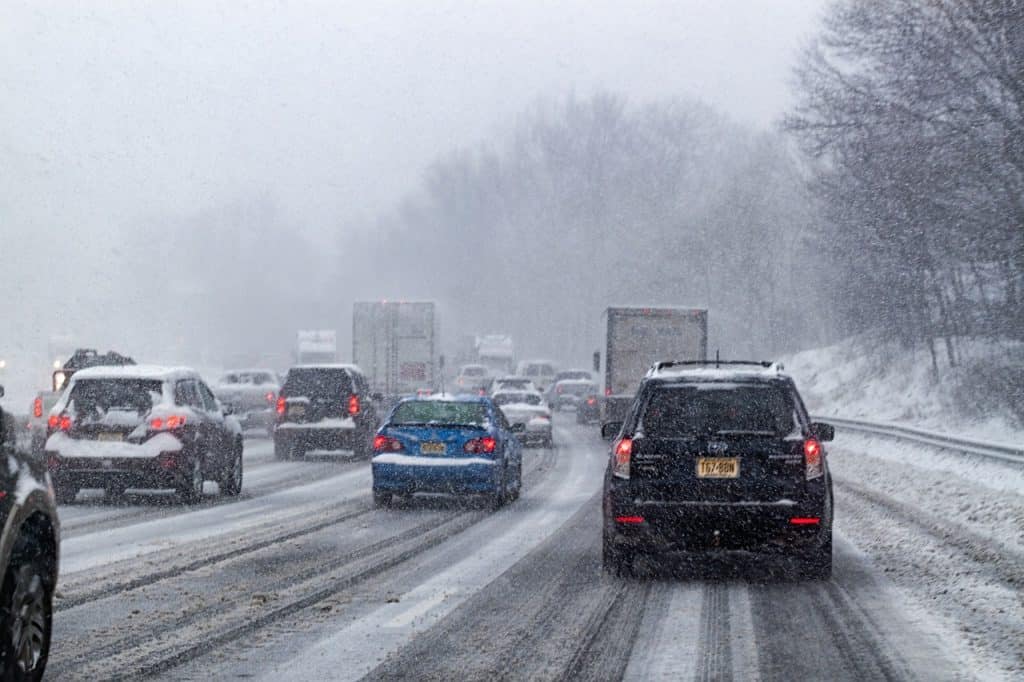We know sharing the road with large vehicles such as semitrailers or other RVs can be downright scary. This experience isn't something that escapes us as an RV-based site. Which is why we thought it'd be useful to offer you some guidance. And after some extensive research, we come across some tips that'll help make this experience much safer.
 When sharing the road with a large truck, doing these 8 things will help keep roads safe for everybody:
When sharing the road with a large truck, doing these 8 things will help keep roads safe for everybody:
- Avoid blind spots
- Stay focused
- Give them plenty of space
- Never cut off a larger truck
- Be wary of steep downhill roads
- Don't forget to signal
- Pass quickly (yet safely!)
- Anticipate wide turns
This overview is brief and doesn't provide all the information about these tips. It's a little bit more complicated, which is something we discuss in further detail later on in this post. So please, read on and learn all about these tips that'll help make the roads safer for everybody!
8 Tips For Sharing the Road Safely with Larger Trucks
Driving alongside a larger truck isn't an experience that should be threatening or daunting. After all, we should all be able to share the road without putting our lives at risk. If you follow the eight tips mentioned above, this dream of a safer driving environment can quickly become a reality.
This is true whether you're driving an RV, or sharing the road with an RV - or both! If you got to this page and you're a sedan driver, these tips are just as applicable and important.
And since we're dedicated to making roads a safer place, we'll explain these tips in further detail below.
1. Avoiding Blind Spots

The blind spots for larger trucks are much bigger than the ones you encounter as a driver of a passenger vehicle. The biggest one is on the right side, which can block up to three lanes of traffic.
Sounds scary, right? Well, we're here to tell you that sometimes it's downright terrifying. But this blind spot isn't the only one large truck drivers have to worry about; there are also blind spots in other areas: directly in front of the cab, behind the trailer, and on the driver's side.
All these blind spots make it imperative that passenger vehicle drivers avoid these areas the best they can. It will ensure the roads stay safe by merely allowing the large truck driver to see you.
Take a look at this video and learn the "no-zone" spots when you're sharing the road with a large truck:
2. Staying Focused
It's essential that you don't let the mundaneness of driving affect your focus. We know, driving to you is almost second nature at this point, but staying alert is critical for keeping things safe for everybody.
Keeping your focus allows you to account for a larger truck's slower reaction time; they're bigger in weight and size than a typic passenger car. It makes them more susceptible to collisions or accidents.
Don't make an accident more probable by not being aware of the drivers and other conditions around you. Pay attention to other vehicles, the flow of traffic, weather, and drivers' signals. It will help you minimize the risk of an accident occurring.
If you're driving a large rig yourself - a motorhome or a pickup truck towing a trailer or a 5th wheel, being alert and focused can save your life, regardless of which vehicles you share the road with.
Just read our guide about RV tire blowouts. You'll see that it's the small things that could save your life in the event of a tire blowout: Keeping your hands on the steering wheel and your eyes on the road.
3. Give Them Plenty of Space
One of the biggest mistakes you can make is driving too close to a large truck. It significantly increases the risk of a disaster scenario: if the truck stops suddenly, rolls over, has a tire blowout, etc.
You must leave enough room so that you can safely merge, swerve, and maneuver around traffic. It doesn't matter whether you're on the right, left, front, or back of a large truck. You must leave enough room to operate safely.
Experts agree that a four-second distance between you and the large truck is the best distance to minimize these risks. It will give more than enough room to perform any driving maneuver you need to avoid a dangerous situation.
If you're also driving a big rig yourself, keeping that safe distance is even more important. Did you know that in case of a tire blowout, you'll need to accelerate? Yup. Again, refer to our RV tire blowout guide to see why. They point is, you need space in front of you as well as behind you to stay safe as a big rig.
4. Never Cut Off a Larger Truck
A common sense tip, but we understand how frustrating it can be trying to move around a large truck. But you must resist the urge to cut them off. If you do, it will just increase the risk of something dangerous happening.
After all, the stopping distance of a large truck is much larger than your typical passenger vehicle. You must account for this before merging in front of a large truck. If you don't, you could end up causing a rear-end collision, and that's not a good situation, especially when a big truck is involved.
You can determine if you have enough merging room by ensuring you can see the large truck's entire front end in your mirror. Once you can, you now know it's safe to merge in front of the large truck. Once you do merge, try not to slow down. This will only increase the risk of an accident.
5. Be Wary of Steep Downhill Roads
 Large trucks sometimes have issues stopping on downhill roads. A large truck barreling down a downhill road is a nightmare scenario. It's definitely something you don't want to see coming at you in your car mirror.
Large trucks sometimes have issues stopping on downhill roads. A large truck barreling down a downhill road is a nightmare scenario. It's definitely something you don't want to see coming at you in your car mirror.
Which is why it's best to avoid these trucks altogether on downhill roads. If you can't, be incredibly cautious and never pass or drive in front of them on these roads. Wait until you reach a more level road and then pass them.
6. Don't Forget to Signal
As we've well documented previously, large trucks need more time to react. It takes them a little bit more time to adjust to other driver's operations and movements. Which is why you must signal before you merge, turn, or stop.
You should also signal for an extended period to ensure the large truck driver can adjust properly. We recommend signaling for at least three or more seconds before making your maneuver.
It will give the truck drivers more than enough time and room to anticipate your upcoming movement.
7. Pass Quickly
When you're passing a large truck, lingering isn't a good idea. It will only increase the chances of something terrible happening. Driving alongside a large truck should be a safe, quick experience that's free of any nightmare scenarios.
The way to do this is by passing them quickly and driving toward the shoulder of the road; being closer to the shoulder is better than being closer to the truck itself. If you do pass them quickly, you'll significantly reduce the risk of anything dangerous occurring.
8. Anticipate Wide Turns
Large trucks need a little more operating room to execute turns. Large truck drivers might even start their turns from a middle lane and catch you completely off-guard. They could even end up swinging too wide on a turn and cause some serious issues.
It's best to anticipate these problems before they make the situation dangerous. Squeezing by a large truck right before a wide turn isn't the brightest of ideas. If you notice them about to attempt a wide turn, stop and let them complete the turn before continuing down the road.
Other Factors to Consider When Sharing a Road With a Large Truck
The tips mentioned above will ensure you stay during your encounters with large trucks. But they aren't the only factors you should be considering to keep your driving experiences safe.
Weather Conditions

When the weather becomes problematic, larger trucks become an absolute nightmare to be around. These vehicles tend to kick up whatever has accumulated on the road: snow, rain, mud, etc.
These substances typically land on other drivers' windshields which can cause temporary blindness. This scenario is why it's essential to give a large truck a little more space during lousy weather.
Back off an extra second or two and give them enough space to move along toward their destination. It will make everyone's lives much safer.
The Risk of Override/Underride
Crashing into a large truck is something that nobody wants to experience. It's even scary just thinking about it. But there are things you should be aware of to avoid these accidents from happening in the first place.
You can start doing this by acknowledging what might happen in the event a crash does take place. The two outcomes that are most likely is your car is going to either underride or override the truck.
Underriding is when a passenger car rear-ends a large truck and ends up under the truck on impact. This situation isn't likely going to happen for motorhome RVers. But for 5th wheel trailer owners, it something both they and the passenger drivers around them need to understand.
Overriding is the exact opposite and happens when a large truck rear-ends a passenger car. The large truck ends driving up the back of the smaller car, which results in disaster. This nightmare is something every driver needs to be aware of regardless of your vehicle.
But both of these circumstances can be prevented by giving the large truck room to roam. There's no need to crowd these massive vehicles. It will only cause problems you're not looking to create.
The Large Truck's Weight
This factor is one built solely around common sense; the large truck is bigger than your passenger vehicle. If it crashes into your car, the damage to your car will be much more severe.
As a result, if you see one coming at you, do your best to move out of the way. It's more than likely that the truck doesn't have the ability to move. So act out of self-preservation and do everything you can to get away.
After reading these tips and factors, you should be ready to mingle with large trucks safely. If you follow everything laid out in this article, we promise that the likelihood of something disastrous happening will decrease drastically!
